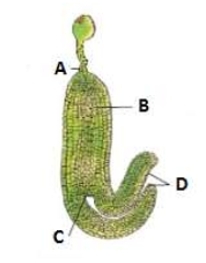What function as the embryonic root of the plant?

1. A
2. B
3. C
4. D

The following diagram shows:
| 1. | Multicarpellary, syncarpus pistil of Papaver |
| 2. | Multicarpellary, apocarpus pistil of Papaver |
| 3. | Multicarpellary, apocarpous gynoecium of Michelia |
| 4. | Multicarpellary, syncarpous gynoecium of Michelia |
Which layer of the anther wall helps in its dehiscence?
| 1. | A | 2. | B |
| 3. | C | 4. | D |
Consider the following statements:
| I: | A monoecious plant bears either male or female flowers. |
| II: | In monoecious plants, autogamy may be prevented but not geitonogamy. |
| III: | Cucurbits and coconuts are monoecious plants. |
| 1. | I and II only | 2. | I and III only |
| 3. | II and III only | 4. | I, II, and III |
Flowers, which have single ovule in the ovary and are packed into inflorescence are usually pollinated by
(1) water
(2) bee
(3) wind
(4) bat
Functional megaspore in an angiosperm develops into
(1) ovule
(2) endosperm
(3) embryo sac
(4) embryo
Wind pollination is common in
(1) lilies
(2) grasses
(3) orchids
(4) legumes
Unisexuality of flowers prevents
(1) autogamy, but not geitonogamy
(2) Both geitonogamy and xenogamy
(3) geitonogamy, but not xenogammy
(4) autogamy and geitonogamy
What does the filiform apparatus do at the entrance into ovule?
(1) It helps in the entry of pollen tube into a synergid
(2) It prevents entry of more than one pollen tube into the embryo sac
(3) It brings about opening of the pollen tube
(4) It guides pollen tube from a synergid to egg
Male gametes in angiosperms are formed by the division of:
(1) microspore
(2) generative cell
(3) vegetative cell
(4) microspore mother cell








